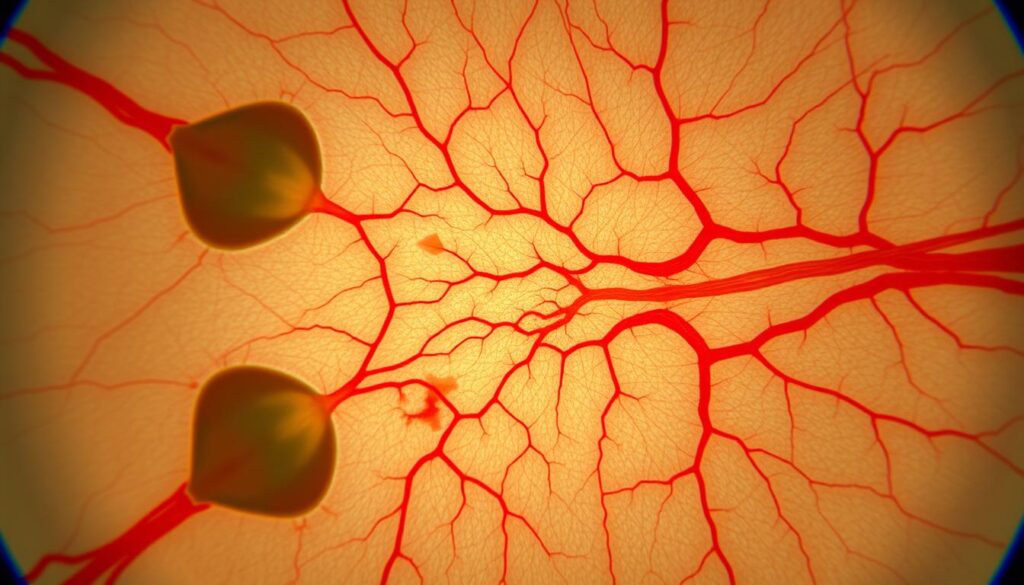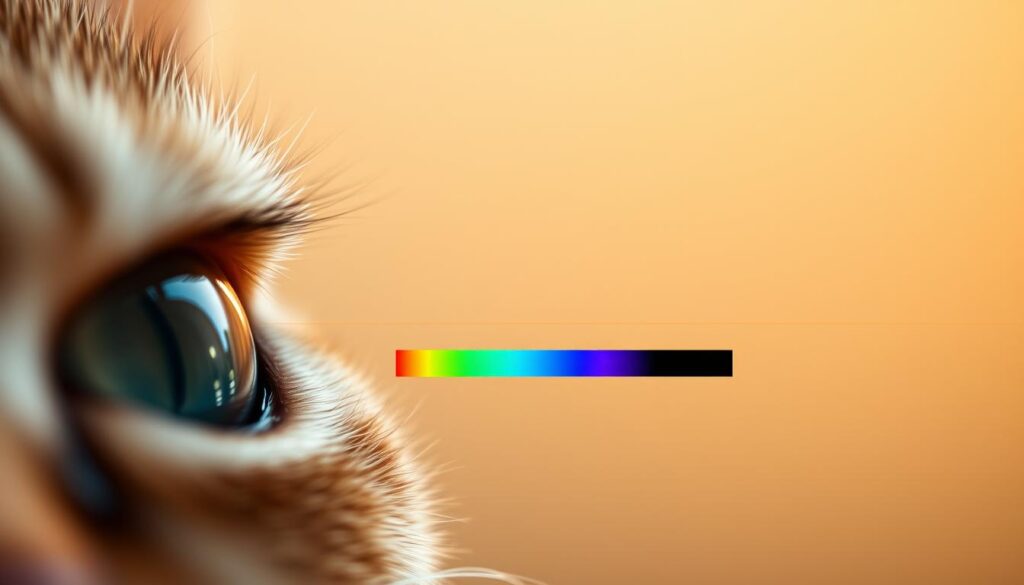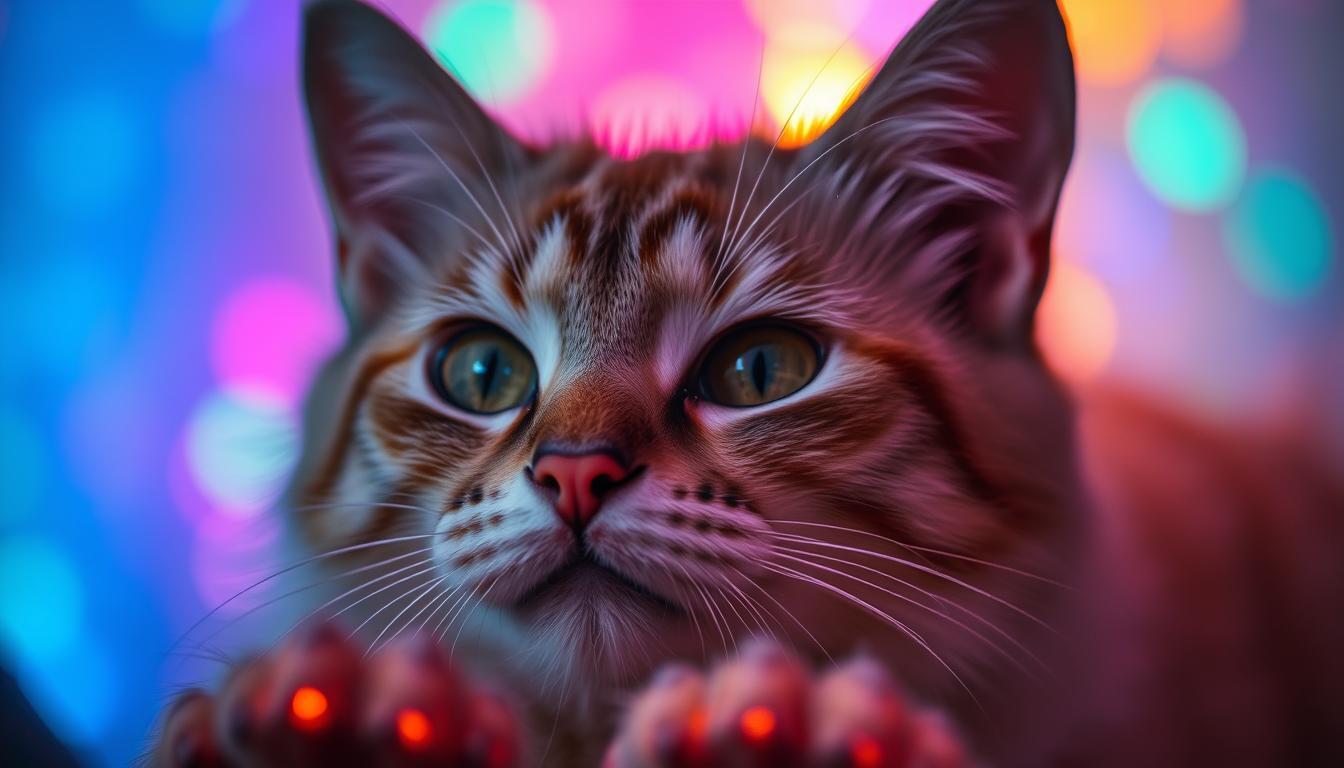can cats see colors
can cats see colors: Ever wonder what your cat sees in a sunny room or colorful toy? The idea that cats see only black and white is wrong. Science shows their vision is more complex and interesting than we thought. Cats see shades of blue, green, and yellow, but reds and pinks look more muted.
This new understanding, supported by Purina and USA TODAY, changes how we see our pets’ lives.
Picture a world where shadows move softly and blues are very bright. That’s what your cat sees. Their eyes are great in the dark, helping them hunt at dusk or spot a moving mouse.
But when it comes to color, their view is different. While you see a rainbow, your cat sees blues and greens more clearly. They use motion and contrast to understand their world. This article explores how their unique vision affects their play, surroundings, and interactions with you.
Key Takeaways
- Cats see a limited cat vision color spectrum, focusing on blue, green, and yellow.
- They require only 1/6 the light humans need to see clearly at night.
- Reds appear gray or brown, while blues capture their attention most.
- Cats have dichromatic vision, using two cone cell types versus humans’ three.
- Understanding their vision helps create safer, stimulating spaces for your pet.
Understanding Your Cat’s Visual World
Cat eyesight is all about motion, shadows, and subtle colors. It’s shaped by millions of years of evolution. Unlike humans, cats see the world in a way that helps them survive, not just look pretty.
Think of your cat’s eyes as a special tool. They have more rod cells than humans, helping them see in the dark. This lets them spot prey even when it’s almost dark. But, their cat eyesight isn’t perfect. They can’t see things as clearly as humans, but they can see more around the edges.
- See blues and grays vividly but struggle with reds and oranges
- Focus better on moving objects than static details
- Have a built-in “night vision” boost from the tapetum lucidum layer
“Cats trade color depth for motion sensitivity,” explains feline vision research. “Their eyes evolved to hunt, not admire sunsets.”
Even though your cat might not see reds and oranges, their world is full of color. Blues and yellows are clear to them. And they can quickly move their eyes to follow any movement. Knowing this helps you make their living space better for them.
The Basic Science Behind Feline Vision
To understand cat eyesight, we must look at their biology. Eye structure, light-detecting cells, and evolutionary needs explain how do cats perceive color. Let’s explore these to see how your cat sees the world.
Anatomy of a Cat’s Eye
Your cat’s eyes have special parts like the tapetum lucidum. This layer helps them see better in the dark. It reflects light back to their eyes, making them more sensitive in low light. Their eyes have two types of cones, not three, which limits their color vision. Key parts include:
- Rods: Detect motion and low-light details
- Cones: Process color but in limited ranges
- Tapetum lucidum: Reflects light to improve night vision
Rods vs. Cones: The Building Blocks of Vision
Rods are more common in your cat’s eyes, helping them track movement better. But, they have fewer cones, which means they see colors differently. Cats see colors like humans with red-green color blindness. Here’s how they compare:
| Human Vision | Cat Vision |
|---|---|
| 3 cone types, vibrant colors | 2 cone types, muted blues/yellows |
| 6 million cones | 1/10th human cone density |
Why Cat Vision Evolved Differently
Cats’ eyes evolved to hunt in the twilight. They can see wide and spot prey in the dark. Their vision is better for catching prey than seeing colors. This is why their world is different from ours.
Can Cats See Colors? The Definitive Answer
Ever wondered can cats see colors or do cats see in black and white? Science shows cats can see more than just black and white. They have two types of cone cells, unlike humans who have three. This lets cats see certain colors, even if their world isn’t as colorful as ours.
- Cats see blues and yellows most clearly, with blue being the most vibrant.
- Reds and greens appear muted, often blending into grayish tones.
- They detect subtle gray-scale shades better than humans, aiding nighttime hunting.
| Aspect | Cats | Humans |
|---|---|---|
| Color Range | Blue and green hues | Full spectrum of colors |
| Cone Cells | 2 types | 3 types |
| Night Vision | 6x better than humans | Less sensitive to low light |
Cats aren’t colorblind, but their colors aren’t as bright as ours. Reds might look greenish, and oranges could appear yellow. Their world is a mix of soft blues, muted greens, and grays. Next, we’ll see how this unique vision helps them in their environment.
The Biology of Color Perception in Cats
Understanding feline color vision begins with the cells in your cat’s eyes. Cats don’t see colors like humans do. They have special photoreceptors called cones and rods. Rods help them see in the dark, while cones detect colors.
Your cat’s cones can only see two types of light. This limits their color range compared to humans.

“Cats have two types of cone cells in their eyes, compared to humans who have three types.” – Kristia Goodnight
Cats see the world in shades of blue and green. Reds and pinks look muted or grayish to them. This is because of cat color blindness.
This is different from humans, who can see a wider range of colors.
- Cats: Two cone types (blue/green) → dichromatic vision
- Humans: Three cone types → trichromatic vision
Genetics play a big role in this difference. Evolution made cats better at seeing in the dark and detecting movement. Their eyes have fewer cone cells than ours.
This means cat color blindness is not a flaw. It’s an adaptation to their environment. Their eyes are made for low light, not bright colors.
When picking toys, remember this. Bright blues or greens will catch your cat’s eye more than reds. Reds might look like shadows to them.
How Cat Vision Compares to Human Vision
Exploring cat vision compared to humans shows how nature helps animals survive. Cats see less color but better in the dark and track movement well. Here’s how they compare in three main areas:
| Aspect | Cat Abilities | Human Abilities |
|---|---|---|
| Color Perception | Blues/yellows (limited spectrum) | Full color range |
| Night Vision | See in 1/6 the light | Requires brighter light |
| Motion Detection | High sensitivity | Less acute |
Color Spectrum Differences
Cats see a narrower cat vision color spectrum. They spot blues and yellows but reds appear gray or brown. Humans see a wide range of colors. This difference helps cats focus on movement over color.
Peripheral Vision and Motion Detection
Cats have a wider field of view than humans, 200 degrees compared to 180. They can spot small movements, making them quick hunters. However, they can’t see distant objects clearly, losing focus beyond 20 feet.
Night Vision Capabilities
Cats see better in the dark than humans, thanks to the tapetum lucidum. They need only 1/6 the light humans do to hunt at night. Their eyes also have more rod cells, improving low-light vision.
What Colors Can Your Cat Actually See?
Cats see colors differently than humans. Their world includes blue, yellow, and green. Reds and oranges look like muted grays. The cat eyes color detection system has only two types of cone cells. This limits their color palette compared to ours. Let’s explore what your cat really sees.

| Color You See | Cat’s Perception | Why? |
|---|---|---|
| Red | Gray or brownish | No red-sensitive cone cells |
| Blue | Bright and clear | High sensitivity to blue-green wavelengths |
| Green | Yellowish tint | Merged with yellow hues due to cone limitations |
| Gray | Distinct shades | Grays appear more varied than in humans |
- Cats see blues and yellows vividly but struggle with reds and oranges.
- They detect the cat vision color spectrum using two cone types, unlike humans’ three.
- Red objects may appear as gray or greenish tones.
Imagine a rainbow through your cat’s eyes: vibrant blues and yellows stand out, while the red end fades to gray. Their world isn’t dull, thanks to their night vision. When choosing toys or furniture, pick blue or yellow to catch their eye. Their color limits are part of an evolutionary design shaped by hunting instincts and twilight activity.
Common Misconceptions About Cat Color Perception
Many myths surround how cats see colors. Let’s debunk three common ones and see what science says.
Myth 1: Cats Only See in Black and White
The notion that cats see only in black and white is wrong. Research shows they have dichromatic vision. They can see shades of blue and yellow and even some greens. This means they can see colors, not just shades of gray.
Their eyes have two types of cone cells. This lets them see a limited but real range of colors.
Myth 2: Cats See the World Exactly as We Do
Cats don’t see the world like humans do. While we see a wide range of colors, cats see fewer. Reds and oranges might look greenish or muted to them.
Their vision is better at seeing motion and in low light. They don’t focus as much on bright colors.
Myth 3: All Cats Have the Same Vision
No two cats see the same way. Their vision can change based on genetics, health, and age. Even their eye color doesn’t mean they see the same things.
Knowing these facts helps us make their world safer and more interesting. Their world is not black and white, but it’s different from ours.
How Cats Navigate Their World Without Full Color Vision
Cats don’t just see colors to know their world. Their cat eyesight is all about motion, light, and contrast. They don’t see colors like we do, but they’ve developed special ways to make up for it.
- Motion Mastery: Cats can spot tiny movements because they have more rod cells than color-detecting cones. This skill helps them catch prey in the dark.
- Night Vision: The tapetum lucidum reflects light, making their night vision better. Their big pupils also help them see in the dark.
- Wide View: Cats have a 200-degree field of view. This is wider than humans, so they can see dangers or fun things around them.
| Adaptation | How It Helps |
|---|---|
| Enhanced motion tracking | Spot prey or toys even in low contrast |
| Tapetum lucidum | Mirrors light for clearer night vision |
| Blue/green sensitivity | Distinguishes shades that matter most in natural habitats |
Your cat uses smell and hearing to make up for what color can’t do. Even if a bright red toy looks dull, its movement will catch your cat’s attention. Taking your cat to the vet regularly is important. It helps catch any eye problems early. Cats create a rich world by focusing on motion and light, even without seeing colors like we do.
What This Means for Cat Owners and Pet Products
Learning about your cat’s cat vision color spectrum can improve their care. It helps you make choices that match their natural abilities.
“Understanding cat vision can help owners choose more effective toys and create more cat-friendly environments.”
Choosing Cat Toys Based on Visible Colors
Experts suggest toys in blue, yellow, or high-contrast patterns. Cat color blindness makes red or green toys seem dull. Choose:
- Interactive toys in bright blue or yellow hues.
- Contrasting colors to make them more visible during play.
Creating a Cat-Friendly Home Environment
Follow these tips to make your home better for your cat’s vision:
| Best Colors | Avoid These Colors |
|---|---|
| Blue, yellow, and grayscale contrasts | Red, green, or orange shades |
| Light-colored floors for depth perception | Busy patterns or low-contrast decor |
Senior cats might need more light to move around better.
Why Cats May Ignore Certain Colored Objects
Red toys on green carpets might look gray or muted to cats. Their cat vision color spectrum makes warm tones hard to see. If your cat ignores a toy, try:
- Switching to blue or yellow alternatives.
- Adding motion to catch their eye.
If your cat’s behavior or eye health changes suddenly, see a pet ophthalmologist.
How Scientists Study and Test Feline Color Vision
Understanding feline color vision is tricky because cats can’t tell us what they see. Scientists use special tools to figure out how cats see the world. Here’s how they find out if can cats see colors:
- Behavioral tests: Cats learn to touch colored panels for treats, revealing color preferences.
- Electroretinography (ERG): Measures electrical signals in retinas when exposed to different wavelengths.
- Eye-tracking technology: Monitors pupil reactions to various hues and brightness levels.
| Method | How It Works | Key Insight |
|---|---|---|
| Behavioral trials | Cats trained to select color-linked rewards | Shows color discrimination abilities |
| ERG testing | Measures retinal electrical responses | Identifies cone cell sensitivity ranges |
| Genetic analysis | Studies cone cell protein structures | Confirms dichromatic vision basis |
Scientists have to overcome challenges like cats’ short attention and instinctive reactions. For example, a 2014 study used reward-based trials to confirm cats see blue and yellow best. They also compare cat retinas to human eyes, finding cats have more rods for low light but fewer color-sensitive cones. These studies show cats see a world with muted colors, unlike ours.
Conclusion: Appreciating Your Cat’s Unique Way of Seeing the World
Your cat sees the world in a special way. They notice muted colors and sharp movements. Their eyes are made for survival, not bright colors like humans see.
Unlike humans, cats have only two types of color receptors. This means they see blues and greens well but not reds. It’s perfect for hunting in the early morning and evening.
When you compare cat vision compared to humans, cats have better night vision and can track movement well. Their eyes have a special layer that helps them see in the dark. They also have more rod cells to catch even the smallest movements.
Cats have a wider field of view but see things up close less clearly. This is why toys in blue or green are more appealing to them than red or orange ones.
Knowing how cats see the world helps you make their environment more interesting. Choose toys in colors they can see and make sure there’s enough contrast. Their world is not less rich—it’s just different.
By understanding their unique biology, you can strengthen your bond with them. They can sense your emotions through body language and sound. This connection is built on mutual understanding.
FAQ
Can cats see colors?
Do cats see in black and white?
How does cat eyesight differ from human eyesight?
What is the anatomy of a cat’s eye?
What are rods and cones in the context of cat vision?
How did cats’ vision evolve?
Can cats see the same colors as humans?
What colors can I choose for my cat’s toys?
What should I consider when creating a cat-friendly environment?
How do researchers study feline color perception?
Source Links
- What Colours Can Cats See? | The Feline Perspective – https://felinefancy.co.uk/blogs/news/what-colours-can-cats-see?srsltid=AfmBOopHN-QbWme43KWwRKn0GhFuylcKJ9IBOTFEVxxbbHOPuKscUqVV
- The Rainbow Through Feline Eyes: What Colors Can Cats See? – https://neakasa.com/blogs/all/what-colors-can-cats-see?srsltid=AfmBOoqYJ6bzs5jKx8p5lBKhaTZSRecyjOueD1zsR5akcy8mDoEa5F9w
- What Colors Can Cats See? A Look into Feline Vision – https://medium.com/@ysflu81/what-colors-can-cats-see-a-look-into-feline-vision-16533dd5bc49
- Can Cats See Color? Understanding Feline Vision – https://www.diamondpet.com/blog/health/conditions/can-cats-see-color/
- 5 Fascinating Facts About What Colors Can Cats See and How They View the World – https://pethealthlove.com/what-colors-can-cats-see/
- What colors can cats see? Here’s how your pet perceives the world. – https://www.yahoo.com/lifestyle/colors-cats-see-heres-pet-110109011.html
- What Color can Cats See: Understanding Cat Vision – https://www.rabbitgoo.com/blogs/news/colors-cats-see?srsltid=AfmBOoom900xD2VheduFb-mNzjSKpXa2fnqBRe0c72vcDRMOz_Y2xxmL
- What Colors Do Cats Like and Can They Really See Them? – https://www.trustedhousesitters.com/blog/pets/what-colors-do-cats-like/
- The Rainbow Through Feline Eyes: What Colors Can Cats See? – https://neakasa.com/blogs/all/what-colors-can-cats-see?srsltid=AfmBOoq0p81I1KZu5GddSbHtJlndu7q87mAipQwWFl057VLg1ujdsSC_
- Can Your Cat REALLY See Colors? Cat Vision Explained – https://www.canadapetcare.com/blog/can-cat-see-colors-explained/
- 24Petwatch: Can cats see colors? – https://www.24petwatch.com/blog/can-cats-see-color
- What Colours Can Cats See? | The Feline Perspective – https://felinefancy.co.uk/blogs/news/what-colours-can-cats-see?srsltid=AfmBOoqcRo3CbtBpgphn4-OHgfVdR5o4XL82YDeRMOw61oBWrVJ9b5mg
- Cat Vision vs. Human Vision: Vet-Reviewed Differences (With Infographic) – Catster – https://www.catster.com/lifestyle/cat-vision-vs-human-vision/
- What Colors Do Cats See | Can Cats See Color & What Colors Can Cats See – https://www.embracepetinsurance.com/waterbowl/article/what-colors-do-cats-see-cat-color-vision-cats
- Can Cats See Colour? Or Are They Colour Blind? | Purina – https://www.purina.co.uk/articles/cats/behaviour/common-questions/can-cats-see-colour
- Can Cats See Color? – https://www.dailypaws.com/cats-kittens/health-care/cat-conditions/can-cats-see-color
- The Rainbow Through Feline Eyes: What Colors Can Cats See? – https://neakasa.com/blogs/all/what-colors-can-cats-see?srsltid=AfmBOop_Yn-oLZxZQkt2IMLu-xW4VLabbFpMuHGbiGVEeYBMXUBiwJ9Q
- Can Cats See Colour? – https://petcube.com/blog/what-colors-can-cats-see/
- Cat vision – How Do Cats See and Do They Perceive Colours? – https://animalhotels.com/gb/blog/cats/cat-vision-how-do-cats-see-and-do-they-perceive-colours
- What Colors Can Cats See? – https://noblevetclinic.com/blog/what-colors-can-cats-see
- What Colors Can Cats See? | Great Pet Care – https://www.greatpetcare.com/cat-health/what-colors-can-cats-see/
- What Colors Do Cats See: Exploring Feline Color Vision – https://www.uahpet.com/blogs/hydration-health/what-colors-do-cats-see-exploring-feline-color-vision?srsltid=AfmBOooXDvXggRl_-XuuM6HApso7joHFAMU8QBdlfa7YULA1VZz5HXgi
- Can Cats See Color? Exploring Their Ability to See Red – https://www.uahpet.com/blogs/hydration-health/can-cats-see-color-exploring-their-ability-to-see-red?srsltid=AfmBOoqCLwGBfg95VPpNeZVa158fOLkuDh9qDaESjzc4-0tR823it3CE
- The Rainbow Through Feline Eyes: What Colors Can Cats See? – https://neakasa.com/blogs/all/what-colors-can-cats-see?srsltid=AfmBOoqxHaHDE3Xvz3MuGfrtoY8Kzp67XESWpKu8uFCTmyex-CncIAtE
- What Colors Do Cats Like? Vet-Reviewed Facts & Preferences Revealed – Catster – https://www.catster.com/lifestyle/what-colors-do-cats-like/
- How Do Cats See Humans: Understanding Feline Vision – https://www.uahpet.com/blogs/hydration-health/how-do-cats-see-humans-understanding-feline-vision?srsltid=AfmBOoqpE4V3zhopmueuAjJm282wOmRxoK95SIE8QrZX9QEnC7IdMZIe
